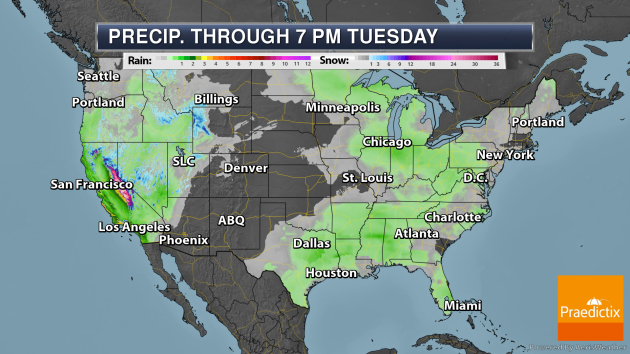Monday’s National Weather Forecast


On Monday, a system across the Southwest will produce rain and higher elevation snow. A warm front stretched from the Northern Plains to the Mid-Atlantic will produce areas of showers and thunderstorms, with some early morning snow across northern Minnesota. Some scattered showers and thunderstorms will also be possible in the Southern Plains and Southeast.

The heaviest snow over the next few days will be out in the Sierra, where at least 3-4 feet of snow could fall. Heavy rain will also occur in coastal areas of California, with the potential for at least a couple of inches of rain falling.

On Tuesday, the threat for severe weather will ramp up across portions of the Ohio Valley with a Slight Risk of severe weather in place. Scattered strong thunderstorms will be capable of large hail and damaging wind gusts.
_______________________________________________
Severe Weather May Impact COVID-19 Coronavirus Response Efforts
More from Forbes: “If there’s one predictable thing we can count on right now, it’s the unpredictability of spring severe weather season. There’s no industry more vulnerable to severe weather right now than our hospitals and the first responders tasked with caring for those with COVID-19, while managing the other ongoing healthcare needs of people. Weather is always a factor when considering the safety of lives and structures, but with the overwhelming response to the COVID-19 crisis and the volatility of spring weather these risks are amplified. Key concerns for hospitals and care units during severe weather events is the continuity of operations, patient care and the safety of healthcare workers. This “all-hazards” approach is constantly tested as there have been several historic, weather events that have decimated hospitals.”
Chile drought causing water shortage amidst virus crisis
More from Phys.org: “With historically low river flows and reservoirs running dry due to drought, people in central Chile have found themselves particularly vulnerable to the coronavirus pandemic. Years of resource exploitation and lax legislation have allowed most reservoirs in that part of the country to run dry. “There are now 400,000 families, nearly 1.5 million people approximately, whose supply of 50 liters of water a day depends on tankers,” Rodrigo Mundaca, spokesman for the Movement for the Defense of Water, the Earth and the Protection of the Environment, told AFP.”
Climate Change Has Doubled Riskiest Fire Days in California
More from Scientific American: “Climate change has doubled the number of extreme-risk days for California wildfires, according to research released yesterday. An analysis led by Stanford University found that temperatures rose about 1.8 degrees Fahrenheit statewide while precipitation dropped 30% since 1980. That doubled the number of autumn days—when fire risk is highest—with extreme conditions for the ignition of wildfires. “That’s a really big increase over a relatively short period of time that can be attributed directly to the changes in climate,” said Daniel Swain, a climate scientist at UCLA and one of the study’s authors.”
_______________________________________________
Thanks for checking in and have a great Monday! Don’t forget to follow me on Twitter (@dkayserwx) and like me on Facebook (Meteorologist D.J. Kayser)!
– D.J. Kayser


